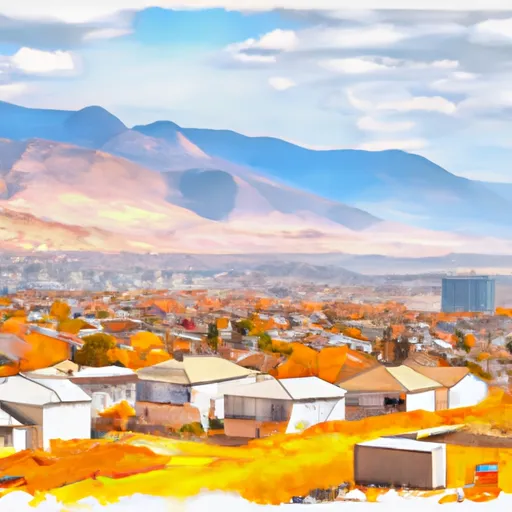-
 Snoflo Premium
Snoflo Premium
Get unlimited access to all our content
With no Ad interruptions! - Start Your Free Trial Login with existing account
Nephi
Eden Index
Climate
9.1
•
Recreation
4.7
•
Community
0.9
•
Safeguard
5.5/10

Nephi, Utah is a small city located in Juab County, nestled in the picturesque Juab Valley. The climate in Nephi is characterized by hot, dry summers with temperatures averaging in the 90s (Fahrenheit) and mild winters with temperatures averaging in the 30s. The region experiences low precipitation, with most of it occurring during the winter months as snowfall.
Hydrologically, Nephi benefits from the nearby Juab River, which runs through the city and provides a source of water for both residents and the local agricultural community. The Juab River contributes to the overall beauty of the landscape, enhancing recreational opportunities.
Nephi offers a range of outdoor recreation opportunities for nature enthusiasts. The city is surrounded by stunning mountain ranges and vast open spaces, making it an ideal destination for hiking, camping, and off-roading. The nearby Nephi Canyon and surrounding national forests provide opportunities for hunting, fishing, and wildlife viewing. Additionally, the area is known for its excellent rock climbing routes and attracts climbers from near and far.
In summary, Nephi, Utah offers a unique climate with hot summers and mild winters, a hydrological system centered around the Juab River, and a variety of outdoor recreation opportunities including hiking, camping, off-roading, hunting, fishing, wildlife viewing, and rock climbing.
What is the Eden Index?
The Snoflo Eden Index serves as a comprehensive rating system for regions, evaluating their desirability through a holistic assessment of climate health, outdoor recreation opportunities, and natural disaster risk, acknowledging the profound impact of these factors on livability and well-being.
Climate Health Indicator (CHI): 9.1
Nephi receives approximately
369mm of rain per year,
with humidity levels near 56%
and air temperatures averaging around
11°C.
Nephi has a plant hardyness factor of
6, meaning
plants and agriculture in this region thrive during a short period during spring and early summer. Most
plants will die off during the colder winter months.
By considering the ideal temperature range, reliable water supplies, clean air, and stable seasonal rain or snowpacks, the Climate Health Indicator (CHI) underscores the significance of a healthy climate as the foundation for quality living.
A healthy climate is paramount for ensuring a high quality of life and livability in a region, fostering both physical well-being and environmental harmony. This can be characterized by ideal temperatures, reliable access to water supplies, clean air, and consistent seasonal rain or snowpacks.
Weather Forecast
Streamflow Conditions
Jordan
Area Rivers
Jordan
Snowpack Depths
Jordan
Reservoir Storage Capacity
Jordan
Groundwater Levels
Recreational Opportunity Index (ROI): 4.7
The Recreational Opportunity Index (ROI) recognizes the value of outdoor recreational options, such as parks, hiking trails, camping sites, and fishing spots, while acknowledging that climate plays a pivotal role in ensuring the comfort and consistency of these experiences.
Access to outdoor recreational opportunities, encompassing activities such as parks, hiking, camping, and fishing, is crucial for overall well-being, and the climate plays a pivotal role in enabling and enhancing these experiences, ensuring that individuals can engage in nature-based activities comfortably and consistently.
Camping Areas
| Campground | Campsites | Reservations | Toilets | Showers | Elevation |
|---|---|---|---|---|---|
| Tinney Flat | 13 | 7,063 ft | |||
| Maple Canyon | 12 | 6,867 ft | |||
| Maple Lake | 7 | 6,422 ft | |||
| Ponderosa Uinta | 29 | 6,265 ft | |||
| North and West Beaches - Yuba State Park | None | 5,067 ft | |||
| Palisade State Park | 75 | 5,931 ft | |||
| Bear Canyon | 6 | 6,631 ft | |||
| Painted Rocks - Yuba State Park | None | 5,002 ft | |||
| Chicken Creek | 7 | 6,102 ft | |||
| Oasis - Yuba State Park | None | 5,037 ft |
Nearby Ski Areas
Catastrophe Safeguard Index (CSI):
The Catastrophe Safeguard Index (CSI) recognizes that natural disaster risk, encompassing floods, fires, hurricanes, and tornadoes, can drastically affect safety and the overall appeal of an area.
The level of natural disaster risk in a region significantly affects safety and the overall livability, with climate change amplifying these risks by potentially increasing the frequency and intensity of events like floods, fires, hurricanes, and tornadoes, thereby posing substantial challenges to community resilience and well-being.
Community Resilience Indicator (CRI): 0.9
The Community Resilience Indicator (CRI) recognizes that education, healthcare, and socioeconomics are crucial to the well-being of a region. The CRI acknowledges the profound impact of these elements on residents' overall quality of life. By evaluating educational resources, healthcare accessibility, and economic inclusivity, the index captures the essential aspects that contribute to a thriving community, fostering resident satisfaction, equity, and social cohesion.

